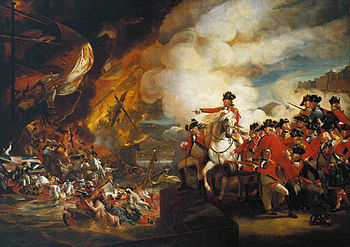
John Singleton Copley was an Anglo-American painter, active in both colonial America and England. He was probably born in Boston, Massachusetts, to Richard and Mary Singleton Copley, both Anglo-Irish. After becoming well-established as a portrait painter of the wealthy in colonial New England, he moved to London in 1774, never returning to America. In London, he met considerable success as a portraitist for the next two decades, and also painted a number of large history paintings, which were innovative in their readiness to depict modern subjects and modern dress. His later years were less successful, and he died heavily in debt. He was father of John Copley, 1st Baron Lyndhurst.

John Trumbull was an American artist of the early independence period, notable for his historical paintings of the American Revolutionary War, of which he was a veteran. He has been called the "Painter of the Revolution".
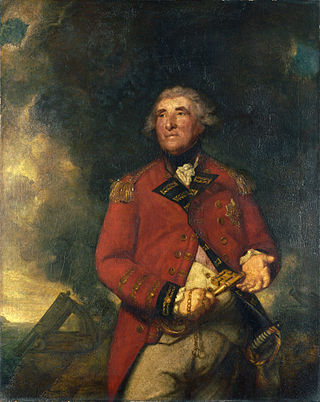
George Augustus Eliott, 1st Baron Heathfield, was a Scottish officer of the British Army, who served in three major wars during the eighteenth century. He rose to distinction during the Seven Years' War when he fought in Germany and participated in the British attacks on Belle Île (France) and Cuba. Eliott is most notable for his command of the Gibraltar garrison during the Great Siege of Gibraltar, which lasted from 1779 and 1783, during the American War of Independence. He was celebrated for his successful defence of the fortress and decisive defeat of Spanish and French attackers.
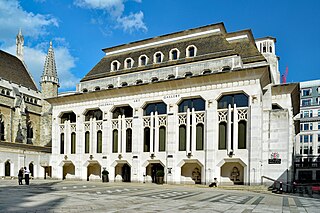
The Guildhall Art Gallery houses the art collection of the City of London, England. The museum is located in the Moorgate area of the City of London. It is a stone building in a semi-Gothic style intended to be sympathetic to the historic Guildhall, which is adjacent and to which it is connected internally.

The Great Siege of Gibraltar was an unsuccessful attempt by Spain and France to capture Gibraltar from the British during the War of the American Revolution. It was the largest battle in the war by number of combatants.
Events from the year 1789 in art.

The Sortie Made by the Garrison of Gibraltar is a 1789 oil-on-canvas painting by American artist John Trumbull. The painting shows a key point in Gibraltar's history when the Great Siege of Gibraltar was undertaken by the Spanish against the British at Gibraltar in November 1781. The Spanish officer Don Jose de Barboza is being given respect as he lies dying. Although left behind by his own retreating troops, he still unsuccessfully attacked the British troops with chivalry.

The Great Siege Tunnels in the British Overseas Territory of Gibraltar, also known as the Upper Galleries, are a series of tunnels inside the northern end of the Rock of Gibraltar. They were dug out from the solid limestone by the British during the Great Siege of Gibraltar of the late 18th century.
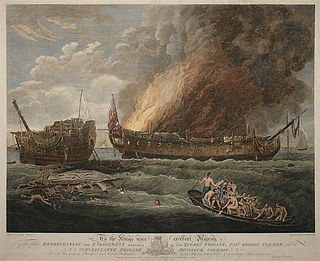
George Carter (1737–1794) was an English artist who described himself as a "historical portrait painter". He visited Italy in the company of John Singleton Copley, who had a significant influence on his work, and spent some time in India.

Don José de Barboza was an officer of the Kingdom of Spain.
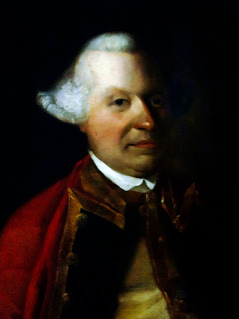
General Sir William Green, 1st Baronet, of Marass, Kent was an officer in the British Army.

The Soldier Artificer Company was a unit of the British Army raised in Gibraltar in 1772 to work on improving the fortifications there. It was the Army's first unit of military artificers and labourers – the existing Corps of Engineers was entirely made up of commissioned officers – and it replaced the traditional but unreliable practice of employing civilian craftsmen. The company was an immediate success and was responsible for upgrading the British fortress's defences before the Great Siege of Gibraltar.

King's Bastion is a coastal bastion on the western front of the fortifications of the British overseas territory of Gibraltar, protruding from the Line Wall Curtain. It is located between Line Wall Road and Queensway and overlooks the Bay of Gibraltar. It played a crucial role in defending The Rock during the Great Siege of Gibraltar. In more recent history the bastion was converted into a generating station which powered Gibraltar's electricity needs. Today it continues to serve the community as Gibraltar's leisure centre.

George Frederick Koehler was a British artist, soldier and engineer. He is known for creating a gun that recoiled allowing it to fire down the side of a mountain without sending the gun carriage flying into the air. The Koehler Depressing Carriage is still commemorated today in Gibraltar where it was an important defence during the Great Siege of Gibraltar.

Major-General Sir Charles Holloway (1749–1827) was an officer in the Royal Engineers. He served at the Great Siege of Gibraltar and returned later as Commanding Royal Engineer when he destroyed the Spanish fortifications between Spain and Gibraltar.

George Mackenzie was a British officer who commanded the 2nd battalion of the 73rd Highlanders during the Great Siege of Gibraltar.

The King's Lines are a walled rock-cut trench on the lower slopes of the north-west face of the Rock of Gibraltar. Forming part of the Northern Defences of the fortifications of Gibraltar, they were originally created some time during the periods when Gibraltar was under the control of the Moors or Spanish. They are depicted in a 1627 map by Don Luis Bravo de Acuña, which shows their parapet following a tenaille trace. The lines seem to have been altered subsequently, as maps from the start of the 18th century show a more erratic course leading from the Landport, Gibraltar's main land entrance, to the Round Tower, a fortification at their western end. A 1704 map by Johannes Kip calls the Lines the "Communication Line of the Round Tower".

The Koehler Depressing Carriage was a novel type of gun carriage invented in 1782 by Lt George Frederick Koehler of the Royal Artillery. It was devised to enable cannon to be fired at a steeply downward-facing angle and was made necessary by the peculiar circumstances that the British Army faced during the Great Siege of Gibraltar between 1779–83. The carriage saw active service during the siege, when it was used to support the British counter-bombardment of Spanish and French artillery batteries during the successful defence of Gibraltar. Its success made Koehler famous and has been commemorated in a number of different forms over the last 230 years.
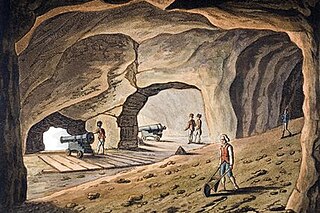
Henry Ince (1736–1808) was a sergeant-major in the British Army who achieved fame as the author of a plan to tunnel through the North Face of the Rock of Gibraltar in 1782, during the Great Siege of Gibraltar. As a result of his work, by the end of the 18th century Gibraltar had almost 4,000 feet (1,200 m) of tunnels in which dozens of cannons were mounted overlooking the isthmus linking the peninsula to Spain. He was one of the first members of the Soldier Artificer Company, a predecessor to today's Royal Engineers, and rose to be the company's senior non-commissioned officer. He was also a founder of Methodism in Gibraltar through his activities as a Methodist lay preacher. Ince spent most of his life in the Army and served for 36 years in Gibraltar before retiring to Devon four years before he died at the age of 72.

George Lewis was a Colonel in the British Army and commander of the Royal Artillery at the Siege of Gibraltar. He served in the several campaigns against the French and Spaniards in America, from 1757 to the end of the war in 1762, and was present at the taking Louisburgh, Quebec, Martinique, and Havannah. He is most famously known for the events that took place on 13 September 1782, at the Siege of Gibraltar, when the artillery under his direction set fire to and destroyed all the floating batteries of the combined forces of France and Spain. For this he was awarded a mark of Royal favour by King George III. He was also a sitter in The Siege and Relief of Gibraltar by John Singleton Copley.
